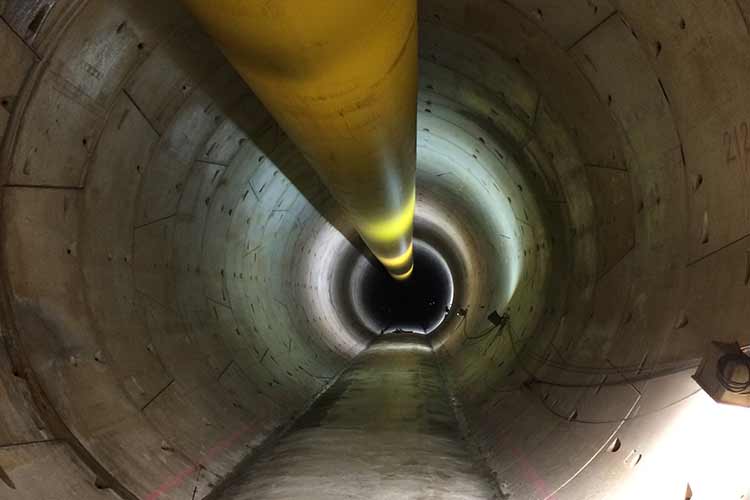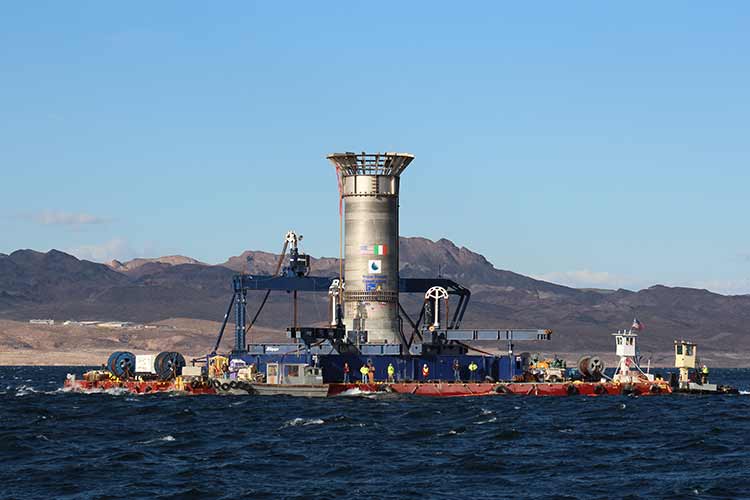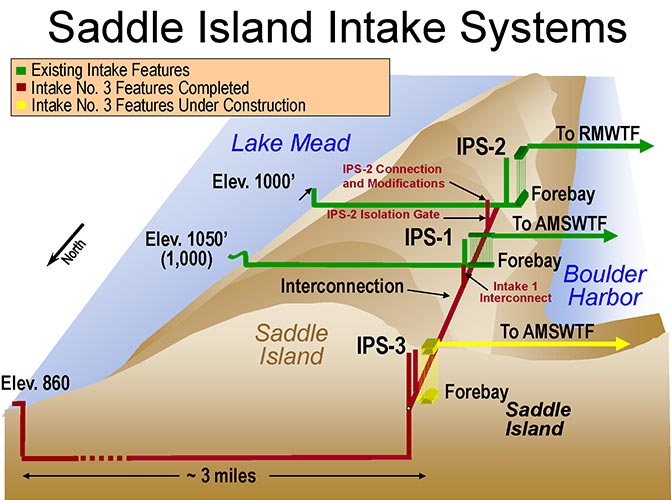
The "third straw" intake tunnel. The three mile, 24' diameter tunnel will provide water to the over two million residents of the Las Vegas Valley. Lake Mead is where the impossible becomes possible - from the creation of Hoover Dam to the construction of the breathtaking bridge high above it - these projects are engineering and technological feats that took lots of ingenuity, manpower, and money to accomplish. But the marvel doesn’t stop there; six hundred feet beneath the lake, a rock-eating machine of epic proportions has chewed its way through some challenging rock to create a three mile-long-tunnel to secure Las Vegas’ access to its primary water supply in Lake Mead. Deemed as the “third straw,” this project is just that – an overgrown straw to draw water from deep within Lake Mead for treatment and transmission to thirsty residents and businesses across the greater Las Vegas area. The first intake pipe in Lake Mead was constructed in 1971. In 2000, a second pipe was constructed at even deeper depths. This may have been the end of the story if it wasn’t for an on-going, historic drought that has reduced the flows of the Colorado River and decreased the amount of water in Lake Mead to a point where lake levels could drip below Las Vegas’ two original intake openings. With Las Vegas relying on Lake Mead for 90% of its water needs, it wasn’t a gamble the Southern Nevada Water Authority (SNWA) was willing to take. A plan was crafted unlike any other ever conducted worldwide1 – the creation of a “third straw”. The entire design and concept of the intake pipe was unique; instead of the pipe coming from above the surface and down into the water, SNWA constructed a subsurface tunnel to come from underneath the lake and pipe the water from the lake’s bottom, similar to a drain on a bathtub. However, this isn’t exactly aa bathtub – it’s a 250-square mile reservoir full of challenges. First, to get to the deeper part of the lake, the tunnel length needed to be a three miles long and the path isn’t straight on; instead, it curves to follow favorable underground conditions like stable bedrock. To do this, an intake structure was secured to the bottom of Lake Mead using 12,000 cubic yards of concrete – that’s enough concrete to pour the foundation of nearly 500 typical Las Vegas homes. Concurrently, crews worked underground to advance the 3-mile tunnel, which connected to the intake with engineering precision. This feat could not have been accomplished using common global positioning systems (GPS), which cannot communicate with satellites 600 feet underground. Instead, traditional survey and engineering methods were employed to ensure proper tunnel alignment. 
The hard job of drilling through bedrock wasn’t the only challenge on this project. The intake structure with the vertical intake pipe was positioned on the bottom of the lake where the horizontal tunnel connected with engineering precision. Another challenge is that the tunnel is going through rock – and a lot of it. First, workers needed to drill, blast and listen for seismic reflections to create a geology map so they weren’t drilling blind. The path for the tunnel begins in Precambrian metamorphic rock and then journeys through the Muddy Creek Formation of required drilling through hard metamorphic rock as well as softer sedimentary rock, that’s over half a mile thick in some areas. Other sediments have been deposited over the ages creating a challenging mix of gravel, boulders and bedrock for the tunnel to go through. Close by, the Las Vegas Wash is draining into Lake Mead, adding a sandy mix of cobbles and rock on top. Lying to the north, a Red Sandstone formation is layered with basalt, up to a hundred feet thick;, further challenging the project . The variety of rock densities and ages was not the only geologic challenge. The numerous faults in the area provided pathways for water to travel into the tunnel. A project this big needs the right equipment; a drilling rig of epic proportions was brought in to do the job. At over 1,500 tons and about the length of two football fields, this was one mammoth piece of equipment. This rig moved inch by inch, drilling a 24-foot diameter tunnel day after day below Lake Mead, for a staggering three years. 
Saddle Island in Boulder Basin is home to all three of the intake pipes used to provide the Las Vegas Valley with Water (IPS = intake pipe system, RMWTF = River Mountain Water Treatment Facility, AMSWTF = Alfred Merritt Smith Water Treatment Facility) Completed in the summer of 2015, the new intake pipe is now in place – and with a final price tag of $817 million dollars. This expensive and challenging project pushes the engineering envelope to provide the two million residents of Las Vegas – and 40 million annual visitors -- the security of water, today and for years to come, all through a tunnel in the bedrock. |
Last updated: April 5, 2017
